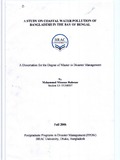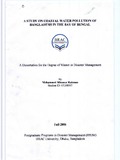| dc.description.abstract | The natural disasters have been regularly taking toll on the people and the resources of Bangladesh. Natural disaster causes inexpressible damage to lives, properties, livestock, life support systems and infrastructures. The coast of Bangladesh is known as a zone of multiple vulnerabilities as well as opportunities. It is prone to severe natural disasters such as cyclones, storm surges, floods, erosion, soil salinity etc. In combination with other natural hazards various forms of man made pollution made the coastal dwellers very vulnerable and ultimately slowed down their socio-economic development. This study will seek to analyze the vulnerabilities and risk of coastal water and suggest adopting appropriate measures for mitigation and management of coastal environmental pollution to the extent of generating environmental awareness among people.
The coastal region gets polluted as the pollutants are carried through different rivers and canals to the sea. Water channels are used for dumping industrial wastes that ultimately end up in the sea. There is no facility for waste treatment in densely populated urban areas. As a result, water pollution is increasing. About three thousand ships including oil tankers come to our ports every year. There are several thousand mechanized trawlers and boats that spill oil. Sea is also polluted by oil spill because of accidents in ships. The authority fails to check pollution as they have no receiving or collecting vessels to face the emergency situation during oil spillage. Even our Port Authority has no laboratory to measure the extent of the pollution. Foreign and local ships find the Chittagong Port and its outer anchorage a safe dumping area for their waste, taking advantage of poor laws and their lax implementation due to logistic support.The authority fails to take action against the ships as they flee very quickly after dumping waste in the sea. Besides, ship¬breaking industry is located in Chittagong. Incidents like dumping of wastes into the sea by foreign vessels are also happening. A number of industries namely fertilizers, cement, pulp and paper, food processing, pharmaceuticals, metal, textile, chemical, petroleum and lubricant plants, etc, discharge heavy metals into the coastal water. The use of antibiotics and other chemicals used in shrimp fields is causing pollution in the water, which may harm other aquatic lives. Plastic bottles and other plastic products are most common forms of litter in the coastal water. The rapid and unplanned increase in shrimp culture is also becoming a concern. Shrimp culture in Cox's Bazar uses 620 tons of urea annually. It also generates 15 tons of waste daily, which comes into sea.
The government has already signed a number of international treaties and conventions to check environmental degradation. Integrated Coastal Zone Management (ICZM) activities in Bangladesh were initiated first in the year 1999; thereafter on 17 January 2005 the Coastal Zone Policy has been approved by the Government. This ICZM policy would be followed by its implementing strategy. The proper implementation of this strategy would lead the Coastal Zone Management in a sustainable way. Under the objectives of the Integrated Coastal Zone Management Project (ICZM project), Priority Investment Programs (PIP) are being developed as the operational arms of this strategy. It is possible to address the pollution in the coast through development of partnerships. Pollution in the coast may not be arrested in short term approaches, like experiences from other countries showed that it is a matter of time. Long term vision would be considered in designing the PIP, where the pollution issues to be addressed and its severity would be minimized. Priority actions may include in district development plan as a basis to start a long term investment program to limit the pollution level in the coast. | en_US |


